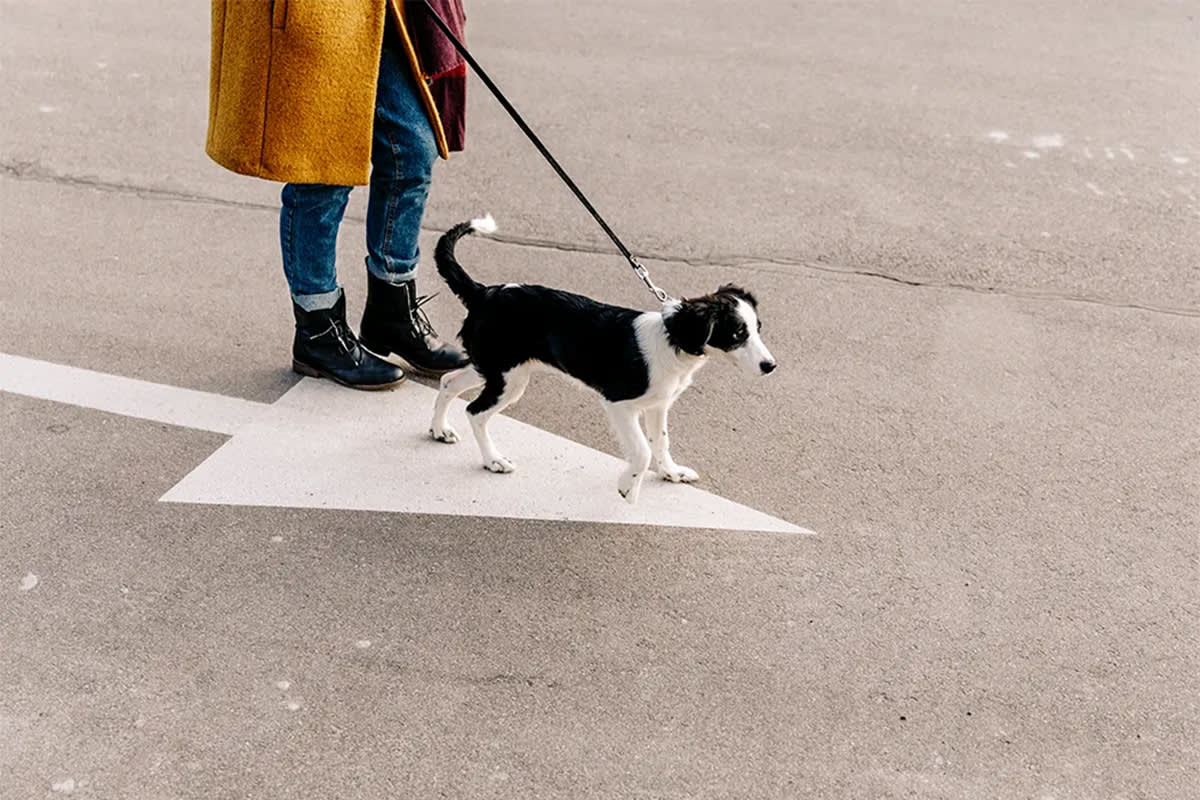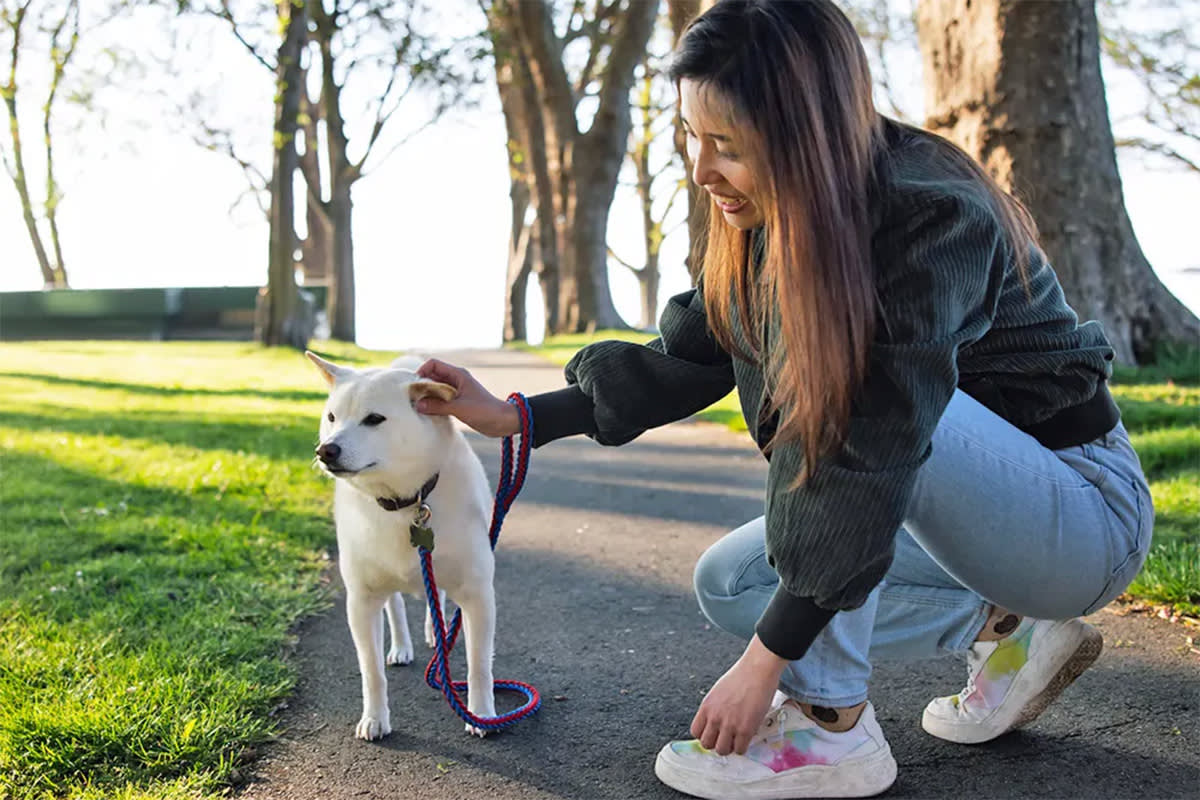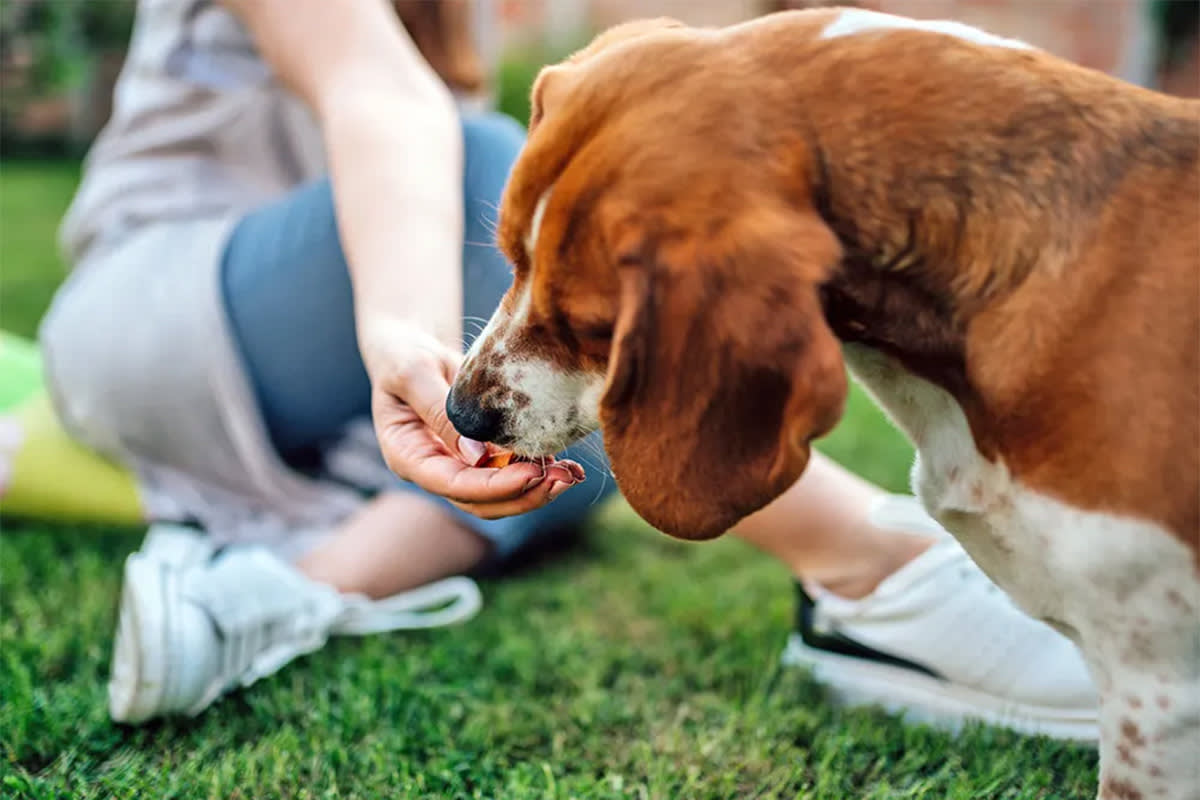The Dos and Don’ts of Approaching an Unfamiliar Dog
How to stay safe and be respectful when you see a cutie patootie out for a walk.
I don’t have a dog. I never have, and I probably never will. But I still love them. Every dog I encounter, I want to interact with. I see them walking along, wagging their tails, tongues hanging out, and I get a huge smile on my face. Without even thinking, I say “hi” in my babiest baby voice and my arm reaches toward them, my index finger twitching like I’m giving them a little phantom scratch behind the ear.
Living in New York City, I experience this involuntary chain reaction daily. I don’t actually touch the dogs, though. My arm goes out, but I don’t bend at the waist. I don’t even get close, unless it happens naturally because we’re walking past each other on the same side of the street. Most of the time, I just let them pass, especially if the person on the other end of the leash looks unfriendly, distracted, or in a hurry. Even if the dog pulls toward me, brushes against my leg, or seems eager to say hi, I still keep my hands to myself. My mother taught me as a child that you should always ask before petting an unfamiliar dog, so that’s what I do.
Save on the litter with color-changing tech that helps you better care for your cat.
But that’s not what everyone does. Some people see a cute dog and dive right in — no permission, no acknowledgment of the pet parent at all. But approaching a dog you don’t know can be risky. A dog might seem friendly from afar but react badly up close. If you don’t check in with their person first, you only have yourself to blame if things go south. Dogs are individuals with their own histories and triggers. No matter how much you think you know about dogs, you can’t predict how any particular dog will respond to your attention.
Nor can you predict how their person will respond. Some pet parents are delighted when strangers want to interact with their dog. Others are not. And some can be downright hostile.
Just look at some of the responses to a recent Reddit threadopens in new tab on the dos and don’ts of approaching unfamiliar dogs:
“Don’t make eye contact with my dog and keep your distance,” writes one user. “Don’t, just don’t.”
“My dog is not here for your amusement,” writes another user.
“If you like dogs so much, you need to get your own,” writes a third.
Harsh! Still, if you want to risk it — and if you’re anything like me, you definitely do — there are some clear dos and don’ts to help make the experience safe and comfortable for everyone involved, humans and canines alike.
What to do (and not do) when approaching a dog you don’t know
DO acknowledge the person on the other end of the leash.
You might notice the dog first, but before interacting, look at the person holding the leash. “The first line of defense with dogs is always to talk to their people,” says Annie Grossmanopens in new tab, professional dog trainer and author of How to Train Your Dog With Love + Scienceopens in new tab. “Make sure to communicate with them directly and never assume anything.”
Communication doesn’t always mean speaking. You can learn a lot by just looking. Do they look friendly? When you smile, do they smile back? If they’re scowling, avoiding eye contact, staring at their phone, or wearing earbuds, leave them and their dog alone. Even if the dog is eager to interact, it’s essential that you connect with their human first. Say, “Hi. Cute dog.” See how they respond. If they’re open to more, they’ll let you know.
DO ask for permission before approaching.
Once you have their attention, ask if it’s okay to engage the dog.
“A lot of people will ask, ‘Can I pet your dog?’ But the question you should really be asking is, ‘Is your dog going to be okay if I approach?’” says Grossman. “Because the answer might be, ‘You can approach, but not pet.’ This is important information for you to have — both for your safety, and the safety and comfort of the dog — and the only person who can give you this information is the one holding the leash.”
Once you’ve asked wait for an actual response. “So many people will ‘ask’ if they can say hi [to my dog] AS THEY'RE ALREADY APPROACHING HER,” writes Reddit user Soft_Gear_410opens in new tab. Be patient.
DON’T get offended if you’re told no.
Pet parents have lots of valid reasons for not wanting strangers to interact with their dog: they might worry you will trigger them, they might be in the midst of training, or the person might just be in a rush. Respect their answer. No explanation required.
“I don’t mind people asking if they respect the no,” writes Reddit user Fun_Orange_3232opens in new tab.
DO go slowly.
Even if you’re given the green light, take it slow. Some dogs need time to warm up. “My dog is the sweetest girl and [nine times out of ten] she’s fine,” writes Reddit user -Its-me-high-opens in new tab. “But she has snapped at dogs and people who approach her fast without warning.”
DO get down on the dog’s level.
Squat. Don’t bend over. “Bending over a dog can stress them out,” says Grossman. “We are so much larger than them and anything coming from over their head will likely be more intimidating than something at their same level. Coming down to their level also gives them more control to back up if they are not interested in a greeting—they can always back away from you—whereas if you come from above they don't have a place to go.”
DON’T get in the dog’s face.
Even on their level, give them space. Let them come to you. Don’t immediately reach for their head. A dog’s mouth is powerful, so respect it.
DO let the dog sniff you.
Dogs understand the world through scent. Let them sniff your hand, but know they might want to sniff more than that. “It is normal for dogs to want to smell our mouths and rears,” says Grossman. “It is what they do with each other. I think it may even be part of why they jump, so they can reach those places.”
DON’T ignore the dog’s body language.
Even if the person says the dog is friendly, trust what the dog is telling you.
“If they are not interested, they will most likely back up, get stiff, yawn, stop and scratch, lick their lips, look at you from the side or squint,” says Grossman. “These are all signs they don't want to say hello, and should be respected.”
Growling and barking are also clear indicators to back off.
“In my experience, most people don’t have good control over their dogs,” writes Reddit user tapknitopens in new tab. “Nor do they have a sense of whether their dog is truly friendly or not. There’s a lot of aggressive dogs out there that the owners feel are ‘friendly.’”
DO follow instructions.
If the person says you can pet the dog, but only while they’re on all fours, follow that rule. If the dog jumps up and the person corrects them, don’t dismiss it. They might be trying to train a specific behavior, and you could undermine it by brushing it off.
DON’T use “I grew up with dogs” as an excuse.
“Assume that you know nothing and the expert on hand is the dog parent,” says Grossman. “And even then, accept that the dog is going to do what it is going to do, not what you want it to do.”
Assuming your experience gives you license to ignore instructions can be dangerous. “I had [a girl] walk towards [me and my dogs] while introducing herself [and as I was] telling her my dogs don’t do well with people, she goes ‘I have 6 dogs so I have experience.’ Like, no,” writes Reddit user Overall_Antelope_504opens in new tab. “My dogs went nuts… my one-year-old [dog] slipped her collar and continued to bark at the girl while she was walking away. Thank god nobody got bit.”
DON’T give the dog commands.
You don’t know their training. Even if they obey, a lot of pet parents are uncomfortable with strangers telling their dog what to do. If the dog’s behavior bothers you, just walk away.
DO offer treats.
If you’ve got a treat, dogs will love you for it, but always ask first. “You have no idea what a dog’s dietary restrictions might be,” says Grossman. “Maybe the dog parent has treats of their own they’d prefer you gave them.”
DON’T engage with off-leash dogs.
“Beware of any dog who is off leash or unattended,” says Grossman. “Even if they seem friendly, the fact is they are missing that first line of defense: their person. Better to be too cautious than not cautious enough. Especially if kids or the elderly are involved.”
DON’T overstay your welcome.
“When in doubt, keep it short,” says Grossman. “Three seconds is often enough time to interact with the dog and get out before they get overwhelmed.”
Setting your dog up for success
If you’re a dog parent who doesn’t want strangers approaching your dog, consider a harness that says “Do Not Pet” or “Nervous Rescue.” Don’t do it for the humans, do it for your dog. If they’re reactive, a simple signal can help prevent unwanted interactions.
Even if you are open to strangers petting your dog, check in with your dog first. If they seem hesitant, it’s up to you to advocate for them.
Once you’re sure they want to meet someone new, let the encounter unfold naturally. “Don’t try to make them sit or follow some other arbitrary command when meeting someone new,” says Grossman. “If your dog is super obedient and a pro at following commands, fine. But when we ask them to perform a behavior like ‘sit’ in the presence of a new person, we are asking too much and trying to exert control over them, which just causes stress and confusion.”
Instead, focus on how your dog is feeling. Try to make the interaction as enjoyable for them as possible. Carry plenty of treats and offer them to people who want to interact with your dog. Not only will it form a positive association, but you can also use them to reinforce good behavior in real time.
Whether you’re a dog lover or a dog owner, Grossman suggests keeping your expectations low. Dog parents: don’t try to control everything. Dog lovers: don’t expect every dog to respond a certain way. Maybe they’ll roll over for belly rubs. Maybe not. It’s up to the dog to set the terms of the interaction.
And if you want to ask them to do anything, just ask them to be cute. That, they can definitely do.





